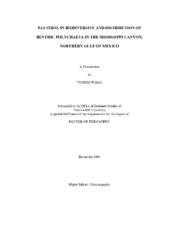| dc.contributor.advisor | Rowe, Gilbert T. | |
| dc.creator | Wang, Yuning | |
| dc.date.accessioned | 2006-04-12T16:01:40Z | |
| dc.date.available | 2006-04-12T16:01:40Z | |
| dc.date.created | 2004-12 | |
| dc.date.issued | 2006-04-12 | |
| dc.identifier.uri | https://hdl.handle.net/1969.1/3058 | |
| dc.description.abstract | The distribution of benthic polychaetes in the Mississippi Canyon was examined to evaluate impacts of environmental variables on species assemblages. Environmental variables considered included depth, bathymetric slope, hydrographic features, sediment grain size, food availability and sediment contamination. Samples were collected using GOMEX boxcorer.
Density decreased with increasing depth exponentially. Diversity exhibited a unimodal pattern with depth with a maximum value in the intermediate depth range (about 1269 m). Deposit feeders were the most abundant feeding guild. Both the feeding guilds and faunal composition could be divided into three groups along the depth gradient: shallow (300 – 800 m), intermediate (800 – 1500 m) and deep (> 1500 m). Results of statistical analyses revealed that depth was the most important determinant in organizing polychaete assemblages in the study area.
The Mississippi Canyon and the Central Transect (a non-canyon area) were found not contaminated by trace metals or Polynuclear Aromatic Hydrocarbons (PAHs) in sediments, although the highest PAHs concentration occurred at the head of the Canyon, MT1. The mean density was higher in the Mississippi Canyon (1668 N/m2) than in the Central Transect (979 N/m2), while the mean diversity in the Canyon (ES(100) = 26.9 ) was lower than the Central Transect (ES(100) = 33.1). Large amounts of terrigenous input from the Mississippi River to the Canyon could enhance polychaete density and accelerate competitive exclusion, and thus lead to lower diversity. The faunal composition was significantly different between the two transects, with higher species richness in the Mississippi Canyon (301 species). This could be attributed to structure complexity in the Mississippi Canyon. The distribution of feeding guilds was similar between two transects. The differences observed in polychaete assemblages between two transects may be largely due to high terrigenous sediment and organic matter input to the Mississippi Canyon by the Mississippi River. | en |
| dc.format.extent | 2012255 bytes | en |
| dc.format.medium | electronic | en |
| dc.format.mimetype | application/pdf | |
| dc.language.iso | en_US | |
| dc.publisher | Texas A&M University | |
| dc.subject | Marine | en |
| dc.subject | Biodiversity | en |
| dc.subject | Environmental Impacts | en |
| dc.subject | Polychaetes | en |
| dc.subject | Gulf of Mexico | en |
| dc.title | Patterns in biodiversity and distribution of benthic Polychaeta in the Mississippi Canyon, Northern Gulf of Mexico | en |
| dc.type | Book | en |
| dc.type | Thesis | en |
| thesis.degree.department | Oceanography | en |
| thesis.degree.discipline | Oceanography | en |
| thesis.degree.grantor | Texas A&M University | en |
| thesis.degree.name | Doctor of Philosophy | en |
| thesis.degree.level | Doctoral | en |
| dc.contributor.committeeMember | Biggs, Doug | |
| dc.contributor.committeeMember | Hubbard, Fain | |
| dc.contributor.committeeMember | Pinckney, James L. | |
| dc.contributor.committeeMember | Wicksten, Mary K. | |
| dc.type.genre | Electronic Dissertation | en |
| dc.type.material | text | en |
| dc.format.digitalOrigin | born digital | en |


